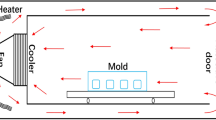Abstract
Since the production of advanced composites, they have gained popularity in many industrial applications because of their unique performances. The advantages of these materials are very important, especially in the area of aviation. Among all the molding methods adopted in their production, the autoclave stands out as distinct method. Considering the temperature distribution in molds, it is one of the crucial aspects to impart quality to composite components during the process of autoclave molding, and it is necessary to do research and analysis on temperature distribution in molds, especially those of large frame-type molds. In previous studies, many authors improved the simulation accuracy simply by changing the grids or boundary conditions. A few of them took boundary layer grids into consideration for further precision. With the aid of computer softwares, this paper conducts simulation on large frame type of molds. Given that the boundary layer grids will largely determine the simulation precision, this study attempts to give emphasis on the study of boundary layer grids to make the simulation results more accurate, and finally make a comparison with the experimental data. The error between simulation and experiment results was within 5 %. This indicated that the boundary layer grids had great influence on the accuracy of simulation of the paper conducted, and should be given more attention. Therefore, the method of simulation in this study can be further used to accurately simulate the temperature distribution in molds.













Similar content being viewed by others
References
Yan D, Liu W, Huang G (2012) Design study for composites autoclave forming mould. Des Manuf Technol Die Mould 7:49–52
Mi Y, Yan Q, Li X, Hong M, Cao M, Zhang X (2015) Effects of temperature induced thermal expansion and oxidation on the Charpy impact property of C/C composites. J Wuhan Univ Technol (Mater Sci Ed) 3:473–477
Yue G, Zhang J, Zhang B (2013) Influence of mold on cure-induced deformation of composites structure. Acta Mater Compos Sin 4:206–210
Nakhaei MR, Naderi G, Mostafapour A (2016) Effect of processing parameters on morphology and tensile properties of PP/EPDM/organoclay nanocomposites fabricated by friction stir processing. Iran Polym J 25:179–191
Gniatczyk JL, Deaver DT (2000) Composite molding tools and processes of forming molding tools. US Patent 6309587 B 1
Michael C, Niu Y (2005) Composite airframe structures. Hong Kong Conmilit Press Ltd, Hong Kong
Prasad N, Vijay KA, Shishir S (2016) Banana fiber reinforced low-density polyethylene composites: effect of chemical treatment and compatibilizer addition. Iran Polym J 25:229–241
Bahramian AR (2013) Effect of external heat flux on the thermal diffusivity and ablation performance of carbon fiber reinforced novolac resin composite. Iran Polym J 22:579–589
Duval M (2005) Investigation and modelling of the heat transfer process in carbon fibre/epoxy composite tools. Carleton University, Canada
Hudek M (2001) Examination of heat transfer during autoclave processing of polymer composites. MSc Thesis, University of Manitoba, Canada
Pirouzfar V, Mosalmani M, Mortezaei M (2015) Experimental study, modeling and optimization to improve heat resistance of modified resole-pitch composites. Iran Polym J 24:829–836
Ding J, Huang Y, Han TZ (2016) Functional graphene nanoflakes/cyanate/epoxy nanocomposites: mechanical, dielectric and thermal properties. Iran Polym J 25:69–77
Vafayan M, Ghoreishy MHR, Abedini H, Beheshty MH (2015) Development of an optimized thermal cure cycle for a complex-shape composite part using a coupled finite element/genetic algorithm technique. Iran Polym J 24:459–469
Gao Y, Qu CH (2012) Numerical simulation about heat-fluid coupling in autoclaves. Ind Furn 4:37–39
Zhang X, Gan ZH, Zhang H (2011) Research on optimization of mold temperature fields in autoclave age forming. Manuf Inf Eng China 19:30–37
Yue G, Zhang B, Du SH (2010) Influence of the mould on curing induced shape distortion for resin matrix thermosetting composites. Fiber Reinf Plast Compos 5:63–65
Zhang CH (2009) Curing temperature field tradeoff design method of large scale composite material structure in autoclave process. Harbin Institute of Technology, Harbin
Zhang J (2012) Research on composite molding process in autoclave based on FEA. Nanjing University of Aeronautics and Astronautics, Nanjing
Yu G (2011) A technology of temperature field analysis in autoclave processing for airplane composite structures. Nanjing University of Aeronautics and Astronautics, Nanjing
Tao W (2009) Numerical heat transfer, 2nd edn. Xi’an Jiaotong University Press, Xi’an
Bai G, Yan D, Zhang D (2013) A study on the temperature field distribute property of large frame type molds. Acta Mater Compos Sin 30:169–174
Zhang CH, Zhang B, Wang Y (2010) Refined simulation on curing temperature field of composite structures. Dev Appl Mater 3:41–46
Zhang CH, Liang X, Wang Y (2011) Rules of impact of autoclave environment on frame mould temperature field of advanced composites. J Mater Sci Eng 4:547–553
Han Y, Guo H, Zhang X (2011) Thermal performance analysis of LED with multichips. J Wuhan Univ Technol (Mater Sci Ed) 6:1089–1092
Author information
Authors and Affiliations
Corresponding author
Rights and permissions
About this article
Cite this article
Chen, F., Zhan, L. & Li, S. Refined simulation of temperature distribution in molds during autoclave process. Iran Polym J 25, 775–785 (2016). https://doi.org/10.1007/s13726-016-0466-0
Received:
Accepted:
Published:
Issue Date:
DOI: https://doi.org/10.1007/s13726-016-0466-0




